Notes: Broadfield station was situated on the Lancashire & Yorkshire Railway (LYR) Bolton – Castleton line which had opened throughout on 20 November 1848. The section of line on which Broadfield stood (between Bury and Heywood) had originally been promoted by the Manchester & Leeds Railway as a connection between its main line at Castleton and the Liverpool and Bury line at Bury then under construction. The company obtained an Act on 9 July 1847 which was the same day that its name was changed to the LYR. The line between Heywood and Bury had opened on 1 May 1848. Broadfield was not one of the original stations of the line, opening two decades later on 13 September 1869.
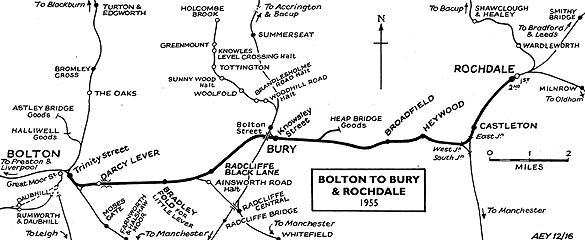 |
Broadfield station was on the southern edge of the settlement after which it was named and on the east side of Pilsworth Road which passed under the line. It was a mile west of Heywood station and three miles to the east of Bury. The locality was a manufacturing district and the large New York Mill was just to the north of the station.
The line was double track and Broadfield station was situated on an embankment reached by a driveway and a sloping path on the north side of the line. The platforms and buildings were constructed of timber. The goods facilities were located on the up side of the line a short distance east of the passenger station. A signal box, located to the east of the up platform and equipped with a 17-lever frame, opened in 1874.
In the early hours of 3 March 1883 a fire destroyed the passenger facilities at Broadfield station. The LYR rebuilt the station in brick at a cost of £11,000. The work was carried out by the contractor Thomas Wrigley of Middleton and was completed by late 1883. The main facilities were still on the up side. They consisted of a single-storey range, lacking in architectural distinction, with rectangular openings finished with stone lintels. Inside the building there were ladies’ and gentlemen’s first class waiting rooms, a booking office, a porters’ room and a lamp room. A canopy with a deep, crenellated valance extended along the length of the building and the width of the platform. A similar building that contained waiting facilities and toilets was located on the down platform.
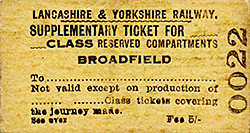 The LYR built a large goods shed at Broadfield in 1883 at a cost of £4,494. It was constructed by Thomas Wrigley Junior and stood on the north side of the goods yard. The yard at Broadfield could accommodate 195 wagons. The LYR built a large goods shed at Broadfield in 1883 at a cost of £4,494. It was constructed by Thomas Wrigley Junior and stood on the north side of the goods yard. The yard at Broadfield could accommodate 195 wagons.
In 1884 a footbridge was installed at the western end of the station. It was a wrought iron structure with a timber floor. It was later provided with glazed sides and a roof.
The December 1895 timetable showed 26 trains each way Monday-to-Friday with an extra train in each direction on Saturdays. On Sundays there were 9 up and 10 down services.
Trains served destinations including Bacup, Bolton Trinity Street, Bury Knowsley Street,
Liverpool Exchange, Manchester Victoria and Rochdale.
The 1904 Railway Clearing House Handbook of Stations listed Broadfield as able to handle general goods and parcels; it was equipped with a 10-ton lifting crane.
In 1912 Broadfield station signal box was replaced with a second-hand LYR Size 4 structure. The new box was sited a little further to the east. The box was initially equipped with a 34-lever LYR frame mounted at the front.
On 1 January 1922 the LYR was taken over by the London & North Western Railway (LNWR). The LNWR merged with other companies to form the London Midland & Scottish Railway (LMS) on 1 January 1923.
In the late 1930s the RAF opened a supply depot on the south side of the line for which sidings were laid out to the west of the station; they opened in 1939. The sidings were operated by a ground frame controlled from Broadfield signal box. During the war the RAF facility was expanded and additional sidings were installed. Because of this in 1943 the lever frame in Broadfield signal box was replaced with an LMS 45-lever frame fitted at the rear of the box.
In the 1940s the down platform building was replaced with an austere brick structure with rectangular openings and what appears to be a flat roof.
By summer 1947 the service consisted of 29 up and 23 down services on Monday-to-Friday. On Saturday there were 31 up and 28 down trains and on Sunday 9 up and 10 down services. Up trains served destinations including Heywood, Manchester Victoria and Rochdale. Down trains served Bacup, Bury Knowsley Street, Bury Bolton Street, Bolton and Wigan Wallgate.
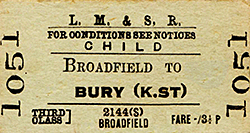 Broadfield became part of British Railways (BR) London Midland Region (LMR) on 1 January 1948. Alone among the BR regions the LMR provided ‘totem’ station name signs quickly and cheaply by printing them on paper posters, and Broadfield is one of the locations where these were displayed. After 1956 conventional vitreous enamel totems and other miscellaneous signs were installed, but gas lighting continued to be used in the station; the signage and lighting would remain in place until closure. Broadfield became part of British Railways (BR) London Midland Region (LMR) on 1 January 1948. Alone among the BR regions the LMR provided ‘totem’ station name signs quickly and cheaply by printing them on paper posters, and Broadfield is one of the locations where these were displayed. After 1956 conventional vitreous enamel totems and other miscellaneous signs were installed, but gas lighting continued to be used in the station; the signage and lighting would remain in place until closure.
BR(LMR) improved the level of service. Throughout the 1950s and into the early 1960s the passenger services remained fairly constant at over 30 departures in each direction on Monday-to-Saturday. Even on Sunday a frequent service was operated. Broadfield enjoyed through services to Bacup, Blackburn, Blackpool, Liverpool Exchange, Manchester Victoria, Oldham, Rochdale, Southport Chapel Street and Wigan Wallgate.
The 1956 RCH Handbook of Stations listed Broadheath as having the same facilities as iin 1904 plus private sidings for the Air Ministry, National Cold Stores Ltd and Broadfoot’s Foundry.
The Reshaping of British Railways (‘Beeching Report’) of 1963 did not list the passenger services on the Bolton – Castleton line for withdrawal but they were in the ‘for modification’ list. On 30 October 1964 BR(LMR) proposed that passenger services between Wigan Wallgate, Bolton, Bury and Rochdale should be withdrawn, and this generated a great deal of local protest. From the start of the winter 1964 timetable Sunday services ceased to operate.
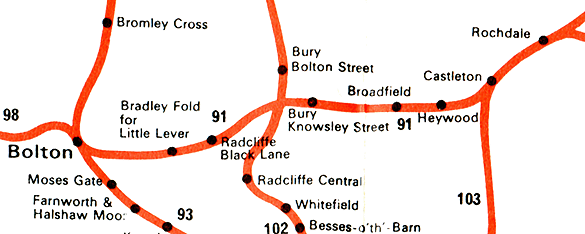 |
On 23 March 1964 Broadfield closed to public goods services but private traffic was still handled.
On 14 September 1966 the Minister for Transport refused to sanction withdrawal of the passenger service between Wigan, Bolton, Bury and Rochdale and consented only to the closure of Lostock Junction station between Wigan and Bolton. Under a separate closure proposal, however, the Bacup-Manchester Victoria service ceased to run after 3 December 1966. The summer 1967 timetable showed 23 up departures on Monday-to-Friday and 26 on Saturday; Sunday services operated between 18 June and 17 September only and 11 departures were provided. In the opposite direction there were 23 Monday-to-Friday departures, 28 on Saturday and 12 on Sunday. Destinations, in addition to Rochdale and Bolton Trinity Street, were Bury Bolton Street, Blackpool (North and South), Wigan Wallgate, Liverpool Exchange and Southport.
On 12 December 1968 BR(LMR) once again published a proposal to withdraw all passenger services from the line and once again local people vigorously objected.
The RAF sidings were disconnected from the main line on 31 March 1968. The ground frame that controlled them was taken out of use on that day.
From 8 September 1969 Broadfield became an unstaffed station. On 7 May 1970 the Minister of Transport, Fred Mulley, approved the proposal to withdraw the passenger service between Bolton, Bury and Rochdale. Notice was given that all passenger services would be withdrawn with effect from 5 October 1970.
The summer timetable for 1970 showed 19 up and 17 down services on Monday-to-Saturday. The last trains ran on Saturday 3 October 1970. The last departure from Broadfield was the 20.19 service to Rochdale. Broadfield station closed completely on Monday 5 October 1970.
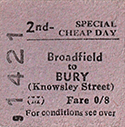 The station buildings were demolished shortly after closure but the platforms survived. Broadfield signal box was closed on 24 January 1971. The station buildings were demolished shortly after closure but the platforms survived. Broadfield signal box was closed on 24 January 1971.
The line through Broadfield became a single-track railway on 14 November 1971 when the up line became bi-directional; the down line was lifted shortly afterwards. The line through Broadfield had been retained to be used by trains between Castleton and Rawtenstall where there was a coal depot. The coal trains ceased to run on 5 December 1980. The Rossendale Farewell rail tour passed through Broadfield on 14 February 1981 and after that date the line was taken out of use.
The track was left in situ but in 1983 the bridge over Pilsworth Road was removed.
On 25 July 1987 the East Lancashire Railway (ELR), a heritage organisation, started to run passenger services between Bury Bolton Street and Ramsbottom. The enterprise was a great success bringing much-needed tourism to the area. However on 16 August 1991 the ELR lost its connection with the national network when the Manchester Victoria and Bury line was closed for conversion to a tramway. The ELR was keen to have a connection to the national network and the solution was to acquire and reopen the line through Broadfield.
A new bridge was installed over Pilsworth Road in 2000. It was higher than the original, which required the line to climb to a higher elevation in order to pass over it. The ELR introduced a service of regular passenger trains between Bury Bolton Street and Heywood on 25 July 2003.
By 2010 the up side of the station had been developed as a housing estate. Both platforms however were extant but heavily overgrown.
Tickets from Michael Stewart and route map by Alan Young
Sources:
- A Regional History of the Railways of Great Britain - Volume 10 The North West - Geoffrey O Holt, David & Charles 1986.
- Forgotten Railways - North West England - John Marshall, David & Charles 1981.
- Lost Stations of North West England - Paul Wright, Silverlink Publishing 2011.
- The Lancashire & Rorkshire Railway, Volume 1 - John Marshall, David & Charles 1969.
- The Lancashire & Yorkshire Railway Volume 2 - John Marshall, David & Charles 1970.
Click here to see the other stations between Bolton and Castleton:
Darcy Lever, Bradley Fold for Little Lever,
Radcliffe Black Lane, Bury Knowsley Street, Heap Bridge Goods,
Heywood (2nd) and Heywood (1st) |

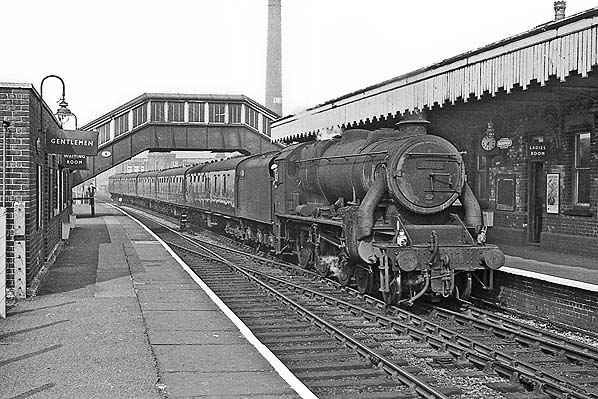
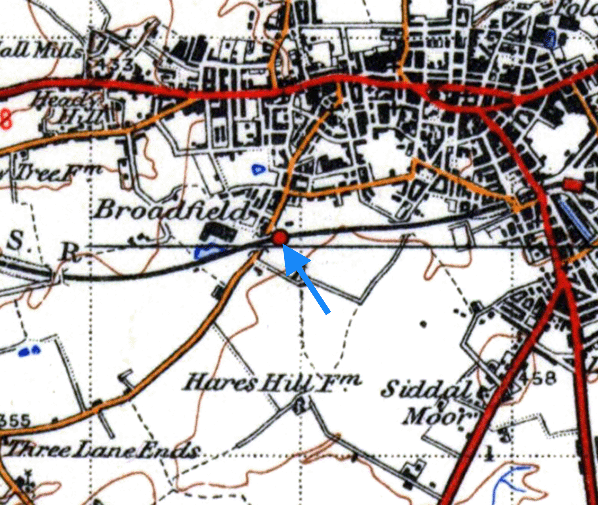
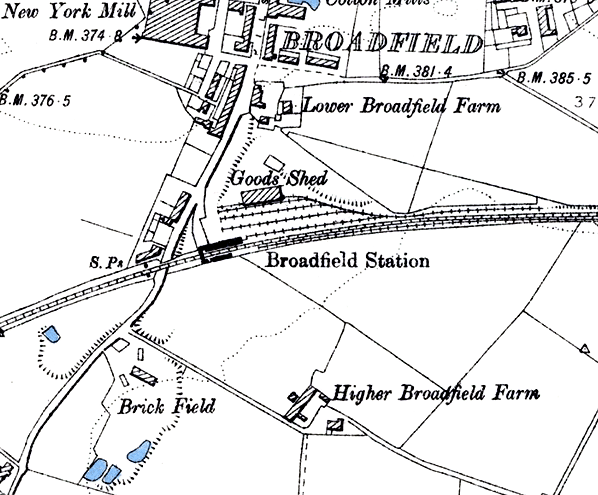
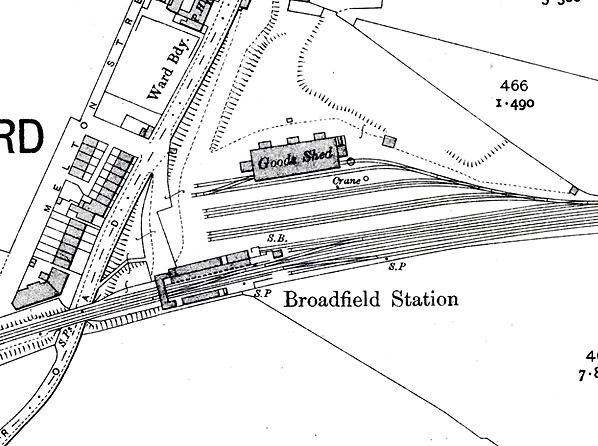
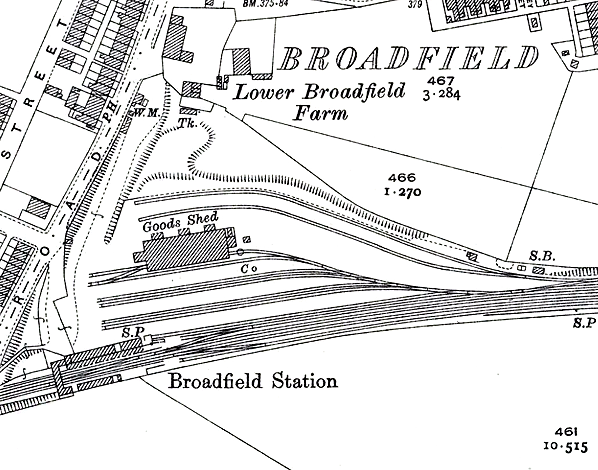
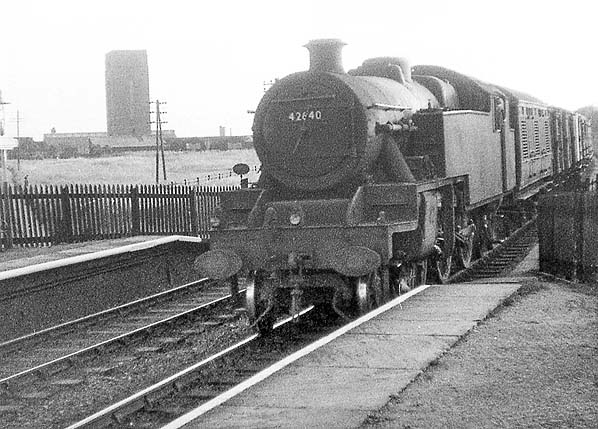
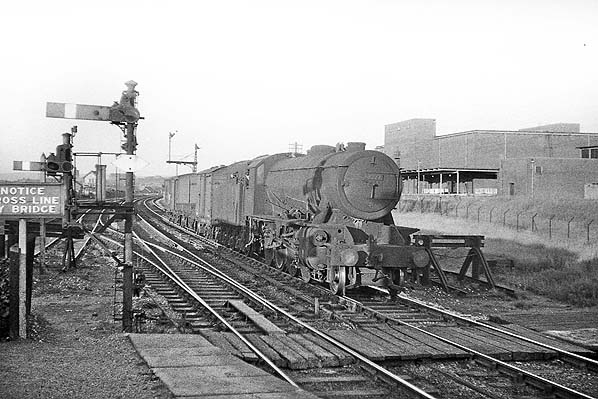
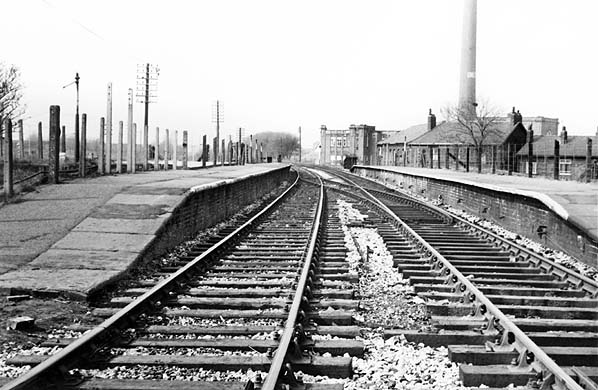
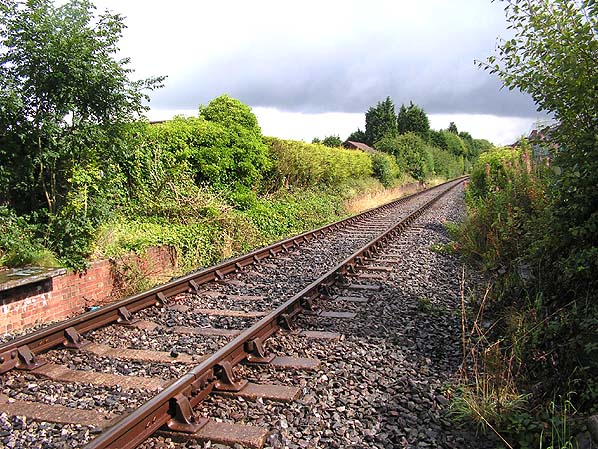

 The LYR built a large goods shed at Broadfield in 1883 at a cost of £4,494. It was constructed by Thomas Wrigley Junior and stood on the north side of the goods yard. The yard at Broadfield could accommodate 195 wagons.
The LYR built a large goods shed at Broadfield in 1883 at a cost of £4,494. It was constructed by Thomas Wrigley Junior and stood on the north side of the goods yard. The yard at Broadfield could accommodate 195 wagons.  Broadfield became part of British Railways (BR) London Midland Region (LMR) on 1 January 1948. Alone among the BR regions the LMR provided ‘totem’ station name signs quickly and cheaply by printing them on paper posters, and Broadfield is one of the locations where these were displayed. After 1956 conventional vitreous enamel totems and other miscellaneous signs were installed, but gas lighting continued to be used in the station; the signage and lighting would remain in place until closure.
Broadfield became part of British Railways (BR) London Midland Region (LMR) on 1 January 1948. Alone among the BR regions the LMR provided ‘totem’ station name signs quickly and cheaply by printing them on paper posters, and Broadfield is one of the locations where these were displayed. After 1956 conventional vitreous enamel totems and other miscellaneous signs were installed, but gas lighting continued to be used in the station; the signage and lighting would remain in place until closure.
 The station buildings were demolished shortly after closure but the platforms survived. Broadfield signal box was closed on 24 January 1971.
The station buildings were demolished shortly after closure but the platforms survived. Broadfield signal box was closed on 24 January 1971. 
 Home Page
Home Page